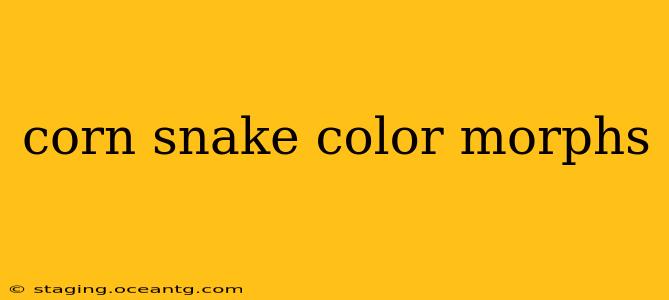Corn snakes ( Pantherophis guttatus) are renowned for their captivating beauty and docile temperament, making them popular pets for beginners and experienced reptile keepers alike. A significant part of their appeal lies in the incredible diversity of color morphs available. This guide delves into the fascinating world of corn snake color variations, exploring the genetics behind them and highlighting some of the most sought-after morphs.
What are Corn Snake Color Morphs?
Corn snake color morphs are variations in the snake's coloration and pattern, resulting from specific genetic mutations. These mutations can affect the base color, pattern intensity, and the presence or absence of certain markings. Breeders carefully select and cross snakes with desirable traits to create stunning new morphs, constantly expanding the already impressive variety. Understanding the genetics is crucial, as some morphs are recessive, requiring two copies of the gene to be expressed, while others are dominant or co-dominant.
How Many Corn Snake Morphs Are There?
There's no single definitive number of corn snake morphs. New morphs are constantly being developed through selective breeding, making it difficult to maintain an exact count. However, hundreds of distinct morphs exist, ranging from subtle variations to dramatically different appearances. This continuous evolution ensures a vibrant and ever-changing market for corn snake enthusiasts.
Common Corn Snake Morphs:
Several morphs are particularly popular due to their striking appearance and relatively easy breeding. These include:
- Amel: This morph is characterized by its lack of red pigment, resulting in a typically yellow or orange body with a more muted pattern.
- Snow: Often considered the ultimate "white" morph, snows lack both red and black pigments. They typically exhibit a creamy white or pale yellow base color.
- Albino: Albino corn snakes lack melanin, resulting in a pinkish-white body with red eyes. This is a visually striking morph highly sought after by many keepers.
- Lavender: These snakes exhibit a diluted color pattern, often appearing lavender or lilac in color. They often have a slightly muted pattern compared to other morphs.
- Stripe: The stripe morph features a distinct, continuous stripe running down its back. This stripe can vary in color and intensity depending on other genetic combinations.
What Determines Corn Snake Color and Pattern?
The color and pattern of a corn snake are determined by its genes. These genes control the production of pigments like melanin (responsible for black and brown colors) and other pigments responsible for yellow, orange, and red tones. The interaction of these genes creates the wide range of morphs we see today. Specific genes control the intensity of the pattern, whether the pattern is present at all (like in an anerythristic morph), and even the eye color.
Are Some Corn Snake Morphs Rarer Than Others?
Yes, the rarity of a morph depends on several factors, including the complexity of the genetics involved and the number of breeders working with that particular combination of genes. Some morphs, requiring specific and complex genetic combinations, are significantly rarer and, consequently, more expensive. The demand also plays a role; highly sought-after morphs command higher prices.
How Much Do Corn Snake Morphs Cost?
The cost of a corn snake morph varies widely, depending on the rarity, age, lineage, and breeder. Common morphs might cost a few hundred dollars, while rarer and more complex morphs can cost thousands. Always purchase from reputable breeders who prioritize the health and well-being of their snakes.
Can I Breed Corn Snakes to Create My Own Morphs?
Breeding corn snakes to create new morphs is a challenging and rewarding undertaking for experienced keepers. It requires a thorough understanding of genetics, careful record-keeping, and a commitment to the well-being of the snakes. However, ethical breeding practices should always prioritize the health and welfare of the animals over creating unique morphs.
Corn snake color morphs represent a fascinating blend of genetics, artistry, and dedication. The endless possibilities continue to captivate enthusiasts, making them a truly unique and enjoyable species to observe and appreciate.
